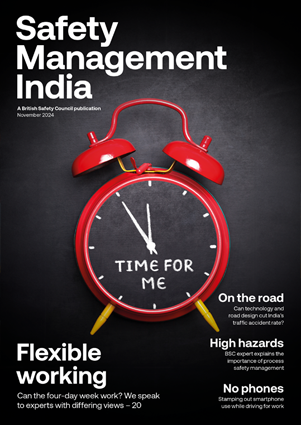For neurodivergent workers, loud and brightly lit offices can cause sensory overload, anxiety and fatigue, so it’s essential to consider approaches such as providing adjustable workspaces, quiet zones and flexible working so they can perform at their best.
Features
Neurodiversity: the new frontier of workplace ergonomics
Creating working environments where people can thrive, maximising productivity and preserving health and wellbeing, is the purpose of ergonomics and human factors. However, for decades the focus has been on physical comfort and safety, and more latterly mental wellbeing too.
Over the past few years, as our understanding and cultural acceptance of neurodiversity has rapidly advanced, businesses have increasingly turned their attention to accommodating the natural variations in human neurological traits seen in conditions such as autism spectrum disorder (ASD), attention deficit hyperactivity disorder (ADHD), dyslexia and more.
But how did we reach this broad new frontier of workplace ergonomics in just a few short years? Where are we now when it comes to understanding and acceptance of neurodiversity? And, from office design to workplace culture, what do employers need to consider in creating more inclusive working environments where neurodivergent employees can thrive?
 Over the past few years, as our understanding and cultural acceptance of neurodiversity has rapidly advanced. Photograph: iStock
Over the past few years, as our understanding and cultural acceptance of neurodiversity has rapidly advanced. Photograph: iStock
The journey so far
While some estimates place the proportion of the population with some form of neurodivergence at 15–20 per cent (DECG Staff, 2022), the language of ‘neurodiversity’ first started to emerge in the late 1990s (LeFevre-Levy et al, 2023) and it is only in the past few years that awareness has really permeated the public consciousness.
Guy Osmond, founder and managing director of Osmond Ergonomics, believes the pandemic helped catalyse this paradigm shift: “Over a short period, we have seen an explosion in conversations about neurodiversity. I think the greater focus on mental health during the pandemic saw employers put mechanisms in place to allow people to ask for help.
That has meant all sorts of other considerations have been brought into the open; people are now recognising and articulating other struggles.
“The other really important factor was the shift to home working during Covid. At home, people could control their working environment to suit themselves – the sounds, the lighting, the temperature, the surroundings. That experience and the subsequent move to hybrid working have thrown into relief the challenges and shortcomings of the office environment, especially for neurodivergent individuals. For those with sensory or processing differences, the ‘traditional office’, which might be loud, brightly lit and filled with visual noise, can be a place of not just distraction, but sensory overload.”
In fact, the demands of dealing with this kind of environment and the increased cognitive load can take a real toll on neurodivergent individuals, leading to more anxiety, fatigue and, in some cases, potential behavioural changes and poor mental health (BSI, 2022).
However, even as the challenges of neurodivergent traits receive wider recognition, we are also becoming aware of the unique strengths that neurodiversity brings. These include enriching the workplace, providing new perspectives and boosting innovation.
 In certain fields, neurodiverse teams have been found to be 30 per cent more productive than others. Photograph: iStock
In certain fields, neurodiverse teams have been found to be 30 per cent more productive than others. Photograph: iStock
For example, the ability of some people with autism to observe and recall detail, recognise patterns, spot illogical processes, or focus single-mindedly on a task have all been linked to business benefits (Krzeminska et al, 2019). Some have noted the association between ADHD, creativity and entrepreneurial success. Research also suggests that dyslexics may have a greater affinity towards holistic information processing, which allows them to make connections more easily and see the bigger picture (LeFevre-Levy et al, 2023).
In certain fields, neurodiverse teams have been found to be 30 per cent more productive than others (Harvard Business Review, 2017). In fact, such is the interest in the benefits of working with such differently-wired brains, that a number of well-known companies, including Microsoft, Goldman Sachs, Google and JP Morgan Chase, have started programmes to recruit and employ neurodivergent workers, claiming several benefits, including increased organisational performance (LeFevre-Levy et al, 2023).
Adds Guy: “Forward-thinking employers are beginning to recognise that, by valuing and accommodating different minds, they can unlock the true potential of their workforce.”
Where are we now?
While some employers are beginning to invest in, for example, training for their HR teams and managers, assessments for staff and modifications to workplaces, not everyone has caught up. Explains Guy: “There are different degrees of awareness and action amongst employers – from those with their heads in the sand (or just completely unaware) to those comprehensively on top of it.
In between, a substantial majority are thinking they need to do something but have no idea what, and don’t know where to go for the training and expertise.
“From an ergonomics and human factors perspective, I think we are now where we were with repetitive strain injury (RSI) 30 years ago when I first came into the field. This was a condition that you often couldn’t see and some employers were very sceptical initially. Thirty years on, RSI is now well-understood and easily mitigated. I think that’s where we will eventually arrive when it comes to neurodiversity.”
Although there is still a relative paucity of literature and research around neurodiversity in the workplace, the British Standards Institution (BSI) published Design for the Mind – Neurodiversity and the built environment just months ago at the end of 2022. They believe this guide to be “the first developed by a national standards body that provides built environment guidance for multiple sensory processing differences and conditions”.
 When thinking about neurodiversity the key is in the name, says Guy. “It’s about diversity. You will never create one space that suits everyone."
When thinking about neurodiversity the key is in the name, says Guy. “It’s about diversity. You will never create one space that suits everyone."
Assessment and support services have similarly struggled to keep up and demand is now vastly outstripping resources in many areas, with waiting lists for ADHD specialist assessment reaching four years in some parts of the UK (inews, 2023).
But this is still ‘the tip of the iceberg’, believes Guy: “Even as people come forward seeking assessment and help, there are many more on the sidelines, looking to see what happens for their colleague before they step forward themselves.”
Where can employers start?
When thinking about neurodiversity the key is in the name, says Guy. “It’s about diversity. You will never create one space that suits everyone, but by offering a choice of provisions, such as alternative spaces or the ability to adjust the environment, you can accommodate a wider range of minds and personalities.”
Here are some key areas employers can consider:
- Flexible work arrangements: Offering flexible schedules, remote work options or adjustable workspaces can help people work at the time and in the way they are most productive.
- Sensory-friendly environments: Consider reducing noise levels, and avoiding harsh lighting, powerful colours and strong smells/perfumes which can be stressors for those with sensory and/or information-processing differences. Creating quiet zones/pods, where sensory input is minimised, can be useful.
- Clear communication and expectations: Transparent communication and formalising and articulating ‘workplace norms’. For example, providing clear guidelines around email/communication etiquette defines expectations and can help minimise misunderstandings.
- Consider the proxemics: Make allowances for the different amounts of space that people feel they need to have between themselves and others due to cultural and/or neurological differences.
- Communication via multiple modalities: Investing in technology such as text-to-speech software or adaptive communication tools, can not only support those with neurodivergent traits but those with visual and auditory impairment too.
- Neurodiversity training: Training programmes for managers and staff can promote understanding and empathy, fostering an inclusive and supportive work culture.
“Just by educating yourself and having an awareness of the different ways people perceive and engage with their environment, you can start to add or subtract elements from the office to make life easier,” adds Guy. “And wherever possible, consult with neurodivergent employees – they will be best qualified to identify the challenging elements of any space.”
Crucially, for an accepting and inclusive approach to neurodiversity to prevail, it must be championed at every level of an organisation, starting from the top. Adds Guy: “Company leaders play a crucial role in promoting an inclusive culture, where diverse voices are heard and valued, and inform decision-making processes.
“For my part, after 30 years in ergonomics and the business of workplace wellbeing, I find this new appreciation of neurodiversity – in fact, the embracing of diversity of every kind – incredibly exciting.
“Recognising and accommodating workers as the unique individuals they are has always been at the heart of ergonomics. If we can help employers navigate this new frontier and provide inclusive working environments which allow people to flourish and perform at the peak of their powers, the benefits to health and wellbeing, as well as productivity, innovation and problem-solving, could be enormous.”
For information and advice on ergonomics and office work, see: ergonomics.co.uk
Guy Osmond is Founder & managing director of Osmond Ergonomics


FEATURES
Why changes to recycling legislation in England are an opportunity, not a burden
By on 12 November 2024

Road safety in India: could better road safety, vehicle technology and enforcement make driving for work safer?
By Orchie Bandyopadhyay on 10 November 2024
India has a poor road safety record, and research shows that commercial vehicles are a major contributor to the problem, with trucks estimated to be the single largest vehicle type involved in impacts leading to fatalities. We look at solutions that could make driving for work and the roads in general safer – from in-vehicle technology that warns truck drivers about unsafe behaviour to improving the design features of major highways.

